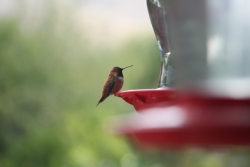
Courtesy and Copyright Ron Hellstern, Photographer

Courtesy and Copyright Ron Hellstern, Photographer
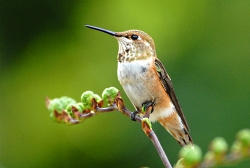
the rufous hummingbird
has the longest migration
in the world in relation to its size.
Photo courtesy and
Copyright © 2010 Michael Fish
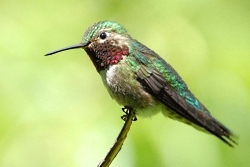
Selasphorus platycercus
Copyright © 2010 Michael Fish
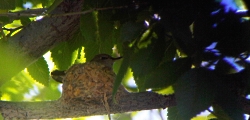
incubating eggs in nest
Archilochus alexandri
Copyright © 2010 Lyle Bingham
(cell phone through spotting scope)
Some scientists are concerned about rising temperatures because flowers are blooming earlier in northern areas, which means that food source may be gone when the hummingbirds arrive.
While they also eat insects, you can attract hummingbirds to your yards with the right plants. They like nectar plants like Columbines, Honeysuckle, Penstemon, Paintbrush, Bleeding Hearts and Trumpet Vines. You can also supplement those nectar sources with feeders.
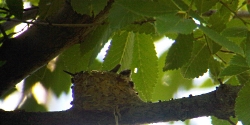
with beak hanging out of nest
Archilochus alexandri
Copyright © 2010 Lyle Bingham
If you’re lucky, the little guys may like your wildlife habitat so much they may even nest there, although those are difficult to see since they aren’t much larger than a quarter. They generally lay two eggs about the size of navy beans, but please don’t disturb the little nest or chicks.
Plant the correct flowers, nesting habitat, and put up feeders, and you may experience one of nature’s flying wonders…the Hummingbird.
This is Ron Hellstern, and I am Wild About Utah.
Credits:
Images: Courtesy & Copyright Ron Hellstern
Audio: Courtesy and Copyright Kevin Colver
Text: Ron Hellstern, Cache Valley Wildlife Association
Additional Reading
Greene, Jack, Rufus Hummingbird, Wild About Utah, Aug 3, 2015,
https://wildaboututah.org/rufous-hummingbird/
Kervin, Linda, Gardening for Hummingbirds, June 5, 2014, https://wildaboututah.org/gardening-hummingbirds/
Liberatore, Andrea, Hummingbird Nests, Wild About Utah, Jun 14, 2012,
https://wildaboututah.org/hummingbird-nests/
Strand, Holly, Hummingbirds in Utah, Wild About Utah, Sept 3, 2009,
https://wildaboututah.org/hummingbirds-in-utah/
Strand, Holly, Heading South, Wild About Utah, Oct 28, 2010,
https://wildaboututah.org/heading-south/
